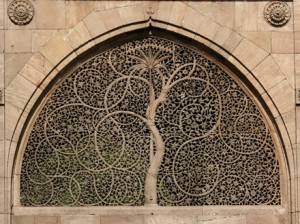 Threshold Society Theme for March 1996
Threshold Society Theme for March 1996
We are embodied spirits–spiritual beings imprisoned or enshrined in bodies of flesh. We can make the mistake of paying too much attention to the desires and needs of the body. Then our spirits weaken and shrink. And we can make the mistake of hating our bodies, of denying our bodiliness in the name of some notion of spirituality. Then we live incomplete and unhealthy lives. Neither of these are the way of Sufism.
The body can be a veil over spirit; and yet if we can awaken spirit, the body can become an instrument of spirit. The Path of Sufism is a path of integration and wholeness–integrating these side-by-side worlds of body and spirit. When we pray, we pray with the body, bringing spirit into relationship with the body. When we turn, the body becomes a means of knowing spirit. Can we look with the eye of the heart to ascertain right action?
The spirit cannot function without the body;
the body is frozen and stiff without the spirit.
Your body is visible, while your spirit is hidden from view:
the business of the world is conducted by means of them both.
God’s providential purpose–to reveal faith or denial–
was fulfilled by means of the marriage of body and spirit.[Mathnawi V, 3423-3424;3428]
If the body and its desires are in the service of an unbridled ego, spirit suffers. The body, too, may suffer from dissolution, misuse, and over-indulgence. When the body is surrendered to the care of spirit, it can be made sacred, whole, and healthy.
Can we bring body and spirit into relationship, experiencing the body as the instrument of spirit? We live in an outer world (zahir), drawing our nourishment from an inner world (batin). It is from the indwelling spirit that we find the strength and clarity to move outward. At times we may need to be content in our bewilderment while we wait for clarity to surface. Eventually, however, when clarity comes, we can unfold into action.
To what extent do we act from the certainty and inner guidance of spirit? When do we leave spirit behind and follow only the inclination of the body? And when do we leave the body aside and sit alone in spirit, not bothering to stand up and live the vision of spirit? How can we more beautifully wed the two? In what aspects of our lives is this most needed? In what ways, however seemingly inconsequential might we better serve this union? During this month let us look to see how better to support the union and manifestation of these two, hand in hand–Hand over hand; Light upon light. (Qur’an, 48:10; 24:35)
Haven’t you seen how gainfully employed
the prophets and saints are?
Haven’t you seen what mines of treasure
have opened to them
from frequenting the shop of Spirit?
[Mathnawi III, 3099-3101]
Task: There may be times when we must listen to the body and learn from it. And equally, there are times when bodily states distort our perception and mislead us. Finally, there are times when the spirit is so strong, the body follows it in adoration! Can we observe examples of these in our lives?

